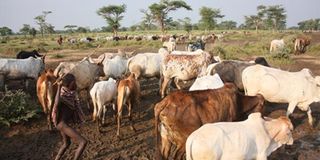Striking a delicate balance: Can agriculture and wildlife co-exist?

A boy tends to cattle. It is always a delicate co-existence with wildlife for communities that live and farm near national game parks. FILE PHOTO
Uganda is an animal treasure and for this, tourists visit and keep returning to explore the vast tropical and savannah grasslands of the wild and what lies therein.
The neighbouring communities in the parks, most of which are farmers, benefit through selling their produce to the hospitality facilities there but for some, this comes as a trade-off.
Geroge Keny lives near Murchison Falls National Park. He grows maize on three acres, cassava on five and chilli on half an acre. Despite chilli being grown on the least space of his farming land, he earns more from it. He however worries about animals destroying his garden particularly elephants from the park and others on its peripherals. As such, he keeps his hands busy mixing grease and chilli. Farmers like Keny rub the mix of chilli and grease onto ropes and tie them around their gardens. The chilli keeps the elephants away because when they taste it, they get irritated and throw-up.
As he does the mixing, he is thinking of money that the chilli he uses could have fetched. Apart from improving local livelihoods, red chilli can be grown as a buffer crop along the edge of the farmer’s fields. Under the February heat, the 53-year-old gets energetic, almost rhythmically, running his feet up and down in soggy soils. The chilli bricks are another way to address the human-wildlife conflict. Awf’s program supports 11 groups with a total of 206 households in 11 parishes in three districts of Nwoya, Oyam and Kiryandongo.
A kilogram of chilli is at Shs7, 500. Babu Olanya, a warden at Murchison Falls says the estimated kilograms of chilli from one acre in the first harvest is 400 kilogrammes to and a maximum of 800 kilogrammes in the second harvest. Awf’s communications officer adds that expected kilograms to be harvested from 12 acres are 4,800 kilogrammes, generating income worth Shs72m, hence annual household income of about Shs350, 000.
He adds, “households have already established individual gardens. Analysis, shows that a household is able to earn between Shs2.4m and Shs4.8m from one acre in the first and second harvests respectively. Groups started harvesting one month ago, and 480 kilogrammes of chilli were sold, generating income of Shs2.9m.”
This increases food security. A good relationship between communities and the park, and good attitude towards conservation efforts is being forged.
Keny is one among many community scouts and a member of Agung Todora Scout Group, a local group, working to improve local livelihoods as they mitigate human wildlife conflict as well as incentivise wildlife conservation.
The efforts to manage the conflict was realised through efforts by Uganda Wildlife Authority (Uwa) and Africa Wildlife Foundations (Awf) who, in partnership, are supporting communities around Murchison to grow red chilli as a non- wildlife tourism enterprise through provision of seeds and farming extension services.
They also train locals on wildlife conflict mitigation strategies, conservation education, and technical practical knowledge in chilli agronomy. Dr. Eric Morris Enyel, a senior warden at Murchison Falls Conservation Area confirms that elephants and chimps continue to pose danger to communities around the park.
“There have also been cases of injured locals by elephants and we have gone to check on them in hospital. We are not mandated to compensate them though,” he explains. He adds that they work with local scouts in communities.
Gertrude Kirabo in charge of community affairs at the park explains that 22 community scouts readily respond to animal invasion, “Scouts use rudimentary methods. Sometimes they sound drums and vuvuzelas to alert more people in the communities. Rangers are then called in. They use AK47 guns which they fire to scare elephants off.”
Awf implements a biodiversity program that follows a modelling strategy through the ‘Conservation Enterprise Development Model’. Its communication officer, Abiaz Rwamwiri says that it aims to provide communities with economic opportunities that improve local livelihoods.
The increase in wildlife,human population and that of crop farms close to the protected area has exacerbated human-wildlife conflict. Elephants are singled out for destroying crops which lead to food and economic insecurity. This has significantly strained the relationship between the park and the neighbouring communities. Lake Mburo National Park’s assistant warden, Noel Abaho says they are trying to maintain a good relationship with communities around the park.
Mburo collects between Shs1.8 to Shs2b a year and they remit Shs218m to communities around the park. With the funds, the park warden says communities have built 17 schools, dams, rehabilitated roads, started individual goat-rearing schemes and put up health centres. The investigation of the actualities of these is yet to be verified.
Besides the chilli, locals have also come up with more methods to deal with problem animals. Digging trenches is another. Esther Abur, another member of Agung Todora Scout Group, says that the trenches help keep animals off their gardens since they are wide and deep enough. The trenches are a metre wide and a metre deep. Animals cannot jump over the trenches for fear of falling in.




